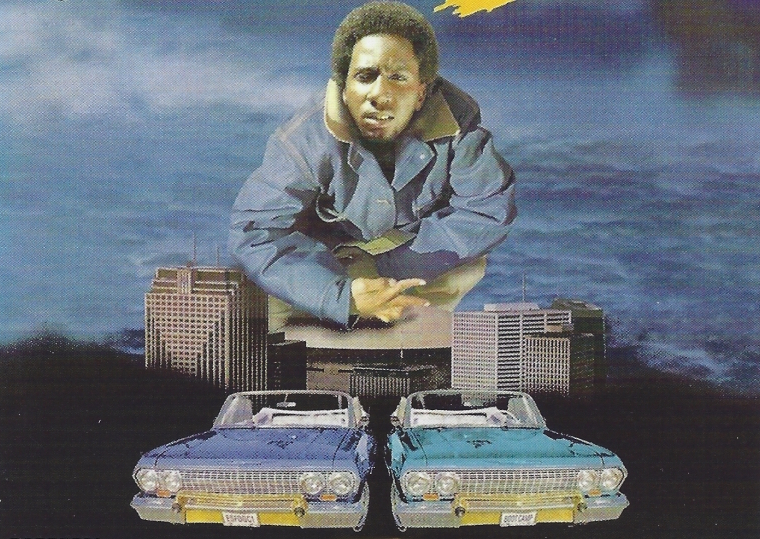The Producers Behind the Beat of New Orleans Bounce
As bounce continues to expand far beyond its base, meet the artists recombining and transforming the genre’s DNA

Bounce, the ferocious style of hip-hop born and raised in New Orleans, is well known these days. Big Freedia, the genre’s breakout star, recently finished the sixth season of her reality show Big Freedia Bounces Back on Fuse, while her vocals were featured on Beyoncé’s “Formation” and Drake’s “Nice For What.” MCs like Fly Boi Keno and the late Nicky Da B have collaborated with mega-producer Diplo. Meanwhile, twerking, a dance intimately connected to the genre, was introduced to (white) America by Miley Cyrus, and has since become a national staple. But while bounce’s quick-tongued rappers and bend-it-over dance moves may be a familiar presence, other aspects of the music – most notably, the producers responsible for much of its sound –have received far less attention.
Like all great genres, bounce is at once seemingly simple and incredibly complex. Carefully designed for instant dancefloor appeal, a close listen reveals a music whose chest-shaking roll is subtly, almost endlessly, varied. The product of nearly thirty years of musical evolution, bounce emerged from the intertwined creative practices and social spaces of its city, reflecting the innovation of its musicians, the deeply rooted traditions of its culture and its well-documented love of a very good time. As a result, the style is a living history of hip-hop era New Orleans, just as much an expression of the city’s realities as the brass band, funk or jazz traditions which came before it. Bounce’s production uses and reuses past elements, folding them into new configurations which, if popular, will themselves become incorporated into the style’s DNA, to be recombined and transformed in turn. As a result, a bounce song from 2018 includes elements that can be traced to distinct moments from across the genre’s history – a kick drum pattern taken from 1986 runs up against a record scratch from 1996, a vocal hiccup from 2002 and a drum breakdown first sampled in 2010.
Bounce producers easily rank among the United States’ most consistent and most compelling electronic musicians.
This remarkable sonic conversation is at least partially due to the fact that an overwhelming majority of the bounce released in the last two decades has been created by a small handful of producers. Operating largely behind the scenes, their work is best recognized by their tags – the bright singsong of “That’s My DJ Showboy CJ” or a drawled “Alright Slash,” dropped at the beginning of a track. Not only do the producers pretty much all know each other, but they came up together, learning their craft by hanging in the studio with more experienced mentors, and repaying the favor once they were established themselves.
Start speaking to one, and the conversation inevitably leads to others, reflecting a network of friends, label-mates and neighbors that defines the genre. Visiting producer Flipset Fred in his studio, I met J-Dawg, who was hanging on the couch. J-Dawg collaborated with DJ Money Fresh on a hit remix of Adele’s “Rolling In The Deep,” a track that stands as one of modern bounce’s finest moments. Money Fresh came up as a respected elder and role model in an interview with DJ BlaqNmilD, who also spoke of how he had introduced DJ Slash (among others) to digital production. These days, Slash frequently produces for Sissy Nobby, a bounce legend on whose computer Flipset Fred made his first beat. Fred explained it like this: “We work hand in hand… We sit there, and we go back and forth on different songs and different new ideas… It’s super cool to be the ones who are really making the song.”
The importance of that last point is impossible to overstate. While bounce may be an offshoot of hip-hop, its modern producers play a notably different role than their counterparts in New York or Atlanta. With lyrics often consisting of only a handful of words, chopped and looped in an ever-shifting rhythm, producers are responsible for structuring both the beat and the vocals on top of it, erasing the distinction between the MC and their backing track. As a result, the scene functions less like rap and more like the dance music it has become. And although they’ve long been overshadowed by charismatic MCs, a closer look at bounce’s producers offers ample rewards. Far from faceless, they are sonic innovators who have created decades of distinctive work, easily ranking among the United States’ most consistent and most compelling electronic musicians.
In the beginning, bounce was based on Triggerman, and Triggerman was on vinyl. Officially known as “Drag Rap,” Triggerman is an 808-heavy track from the Showboys, a Queens-based rap group. Quickly fading from memory in New York after its 1986 release, the record made its way south to New Orleans, where DJs began to play its instrumental b-side, using its wide palette of beats and breakdowns as the rhythmic foundation for their own distinctive brand of hip-hop. In the hands of a good DJ, “Drag Rap” provided enough variety and power to keep a party going for hours, maintaining the groove as MC after MC got up to rhyme. While the mid-’90s saw bounce make the jump from late-night clubs to a citywide phenomenon, the Triggerman beat, spun from vinyl, remained at the core of the genre.
That began to change towards the end of the decade, as performers like DJ Duck and DJ Money Fresh started to incorporate MPCs into their performances and remixes, separating bounce from its vinyl roots by chopping up the Triggerman on a sampler. Punching sampled beats gave DJs like Money Fresh an entirely new level of control, letting them play with a precision and flexibility impossible on vinyl. The effect was electric. “It went through the city like Katrina,” Money Fresh says. “It just fucked everything up. Everybody was like, ‘Wow, did you see what Money did last night?’ If people didn’t see it, they heard about it.”
Building on this groundbreaking work, the late ’90s saw a younger generation of producers begin to adopt new techniques, gradually severing bounce from its vinyl roots. Of these producers, perhaps the most influential is BlaqNmild. “My auntie Tessa,” BlaqNmilD answers when asked how he first got into digital production. “I lived with her, and she had a computer.” First signed to Money Rules Entertainment, an influential label that boasted the cream of the early 2000s bounce crop, BlaqNmilD began his career by producing for its cohort of rising stars. Despite a relative lack of experience, skill on programs like Acid gave him an edge. “By me having that program,” he says, “I was able to create my own bounce sound… I changed the tempo, I changed the way the breakdowns went, I made things hit a little harder. I started chopping up the artist’s vocals. That was a big ol’ change in the bounce game as well. Once I started chopping the artist’s vocals, it went crazy.”
Chopping is the most recognizable hallmark of the hyper-speed, breakdown-heavy style of bounce that developed in the early 2000s. Working digitally, producers like BlaqNmilD, Peacachoo and Blaza shifted the aesthetic, taking full advantage of their newfound power to manipulate vocals and rhythms. “It’s not about lyrics too much,” BlaqNmilD explains about the style he helped shape, “It’s about the energy. It wasn’t really about the song, it was about the song giving people a reason to dance.” That energy is maintained by constantly varying the beat – the stuttering syllables of a chopped vocal help, as do the sets of samples and loops painstakingly created by producers. Peacachoo, a prolific producer famous for his remixes, says that he had started developing his own distinctive sound learning from BlaqNmilD. “He gave me like ten samples, and was like, ‘I want you to break all these samples down.’ I turned like ten samples into a 150-something samples. Like the Triggerman beat. You’d break all the bells down, all the claps, all the drums out of it. And you basically disintegrate the track. That’s how you build your samples.”
I’ve created hit records off of artists saying two words.
During the 2000s, digital production gradually shifted the relationship between MCs and producers. Blaza, the head of the label Mpakk Nation, explained the chronology at his studio in the West Bank town of Harvey, across the Mississippi from New Orleans. “When I came on the scene, that’s when the editing became popular. You’d record all the vocals, then go through and filter it down and make a song… That’s a range of about 2003-2006. And then in 2006-2009, it was a lot of one-word tracks where the producer is the song. I may get a whole lot of vocals and filter it down to a sentence, and then I’ll use one word.” During recent years, Blaza said, these tendencies were often taken to an extreme. “I had a friend of mine who challenged me… He wanted all of his songs to be one word. He paid me to go through his vocals and pick out one word. He said, ‘I don’t want to rap, I don’t want to know how to rap.’ I think the most he ever said on a song was maybe three words.”
DJ Slash is a family man, whose warm, friendly vibe offers no hint of the intensity of the music he creates. Speaking in a busy coffee shop during a torrential summer rainstorm, he explained how he had produced “Gimme My Gots,” a hit for the MC Shardaysa Jones. She was new to recording, and as they sat around the studio trying to figure out an angle, something caught his ear. “She was rapping, and she said ‘Give me my gots.’ And I told her to say, “No Slash, give me my gots.” As I’m telling her, I know how I wanted the song to go in my head. I already had it mapped out. I wanted to start it off with tongue rolls, I wanted it to go a cappella for this part, I wanted to punch this part of the beat. I wanted this breakdown.”
While Shardaysa was involved for much of the process, some producers operate with far greater autonomy. BlaqNmilD explains that he had backlogs of vocals from prominent bounce artists, which he could draw on to create new songs whenever he wanted. “Once the vocal is laid down, it’s time for the magic. Whoever’s producing the record, they really do most of the work… I’ve created hit records off of artists saying two words. Three words. ‘Rock the canoe.’ ‘Drop and give me 50.’”
“I did a lot of records for [Big] Freedia over the years,” he says, “and Freedia didn’t even know those records were coming out. He came to the studio, and used to give me so many vocals, that he didn’t even know there were records on him comin’ out… The artist can leave, and it’s just on the producer to be real creative.”
I got a taste of this production style firsthand while interviewing Flipset Fred. Having heard a friend tease me about wanting to record a bounce track of my own, he offered to let me try, “for the experience.” After hashing out a basic concept (“Bounce it like Serena,” in praise of the tennis star), we quickly listed a paragraph or two of phrases for me to rap: “She bounce it like a tennis ball. She serve it like a tennis ball. North side bounce it, south side bounce it, east side bounce it.” To give me the tempo, Fred ran a loop of the “Roll Call” beat, a classic early 2000s rhythm. After running a few bars to get me acclimated, he hit record, and I started repeating my lyrics, in as many permutations as I could think of, for about two minutes. We stopped, Fred gave me some suggestions, and then we did it again. But after that, my part was done. From here, Fred would build the track – picking through my vocals for the best segments, ordering them into something that made sense and then chopping them around the beat. While it would be my name and voice on the track, that’s pretty much all I’d have to do with it.
In the late 2000s, as chopping took over, and lyrics fell away almost completely, producers began to introduce larger samples — known locally as “melodies” – into bounce. Drawn from mainstream pop songs, these samples are thrown under the beat to ride for eight or 16 bars before disappearing, never to return. Unlike traditional hip-hop, which generally prohibits blatant recycling, in bounce conspicuous melodies from artists as varied as Linkin Park, Lauryn Hill or Phil Collins are used again and again. While sometimes, on songs like Sissy Nobby’s heartbreaking “Consequences,” the sample is incorporated into the track, far more often it occupies an entirely different register, standing exclusively as a reference to an otherwise unrelated piece of music. A perfect example of this is “Fischer Fool,” a hit for the popular Reedy, which incorporates melodies from “In The End” by Linkin Park, “Crew Love” by Drake and, most memorably, “Maneater” by Hall & Oates. DJ Slash, who produced the track, explained, “I took that track, ‘Maneater.’ It has nothing to do with Fischer fools. It’s just something different that I wanted to merge.”
Although it didn’t directly affect its musical style, bounce’s development was profoundly altered by Hurricane Katrina, which hit New Orleans in August of 2005. As hundreds of thousands of residents fled to cities like Houston and Atlanta, they brought the music with them, introducing new audiences to their local sound. While most of the refugees have long since returned home, the bounce nights they started have remained, opening up lucrative markets. The aftermath of the storm also provided an opening for a new cohort of bounce performers. Although unapologetically queer MCs like Big Freedia, Katey Red and Sissy Nobby had been prominent before Katrina, they found new support from the mixed-race crowds that began to fill clubs in the rapidly gentrifying Marigny neighborhood. Building on this fanbase, these artists made the jump to the national underground, playing shows and festivals across the country and introducing their music to the world.
In some sense, the last decade of bounce has been an attempt by its artists and producers to work through the promises and challenges posed by these events. Following Freedia’s continued success, as well as a number of high-profile appearances by bounce MCs on tracks like Jack U’s “Beats Knockin’” (Fly Boi Keno) or “Nice For What” (Big Freedia/5th Ward Weebie), there’s a widespread belief that the genre is poised to break out in a major way. BlaqNmilD, who’s responsible for the chopping that carries the end of the recent Drake hit, thinks this kind of exposure will open new doors for bounce artists: “Who doesn’t like to dance? I think we need to just ease it on, sneak it to them.”
Within New Orleans, the last few years have also seen a new generation of women, led by performers like Reedy, Treety, Shardaysa Jones and Bog Vonnie, come to dominate the local scene. Initially produced in the familiar, chop-heavy style, more recently these artists have begun to bring back lyrics, spitting storytelling verses over bounce beats. They’ve also been attracting attention from the outside world – their songs and videos have racked up millions of plays, while Reedy’s “For The D” freestyle went viral as the “For the D Challenge,” with stars like Erykah Badu and Cardi B uploading their own versions. “We came out with the sound because we had no new voices being heard in bounce music,” Bog Vonnie explained, “We switched the game up. It’s not so much booty-shaking music… Our songs tell stories of our lives and our situations.”
Between a happening underground and continued attention from superstars, things seem to be looking good for bounce and the musicians who make it. That’s happened before, though, and experience suggests that it’s all too easy for a sound to be sucked into the mainstream without bringing its creators with it. In the past, says BlaqNmilD, artists from New Orleans didn’t stand behind bounce. Instead, they “stood on it,” taking advantage of what they had without paying it forward. Now, he hopes, things are different. “I’m about to be put in a special place where I can have a little bit more say. The songs that I used to be mixing, [now] I can make them for real.” With some careful planning and the city’s astonishing roster of talent, it might be time for the rest of America to get properly acquainted with a new beat. As BlaqNmilD says, “It’s about to be crazy.”
Additional research for this piece by Jessi Olsen, with support from Afropop Worldwide.

